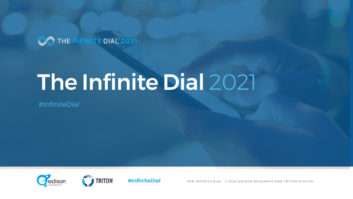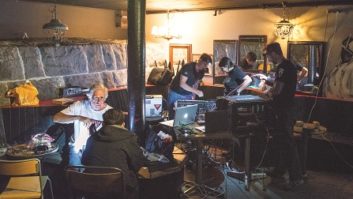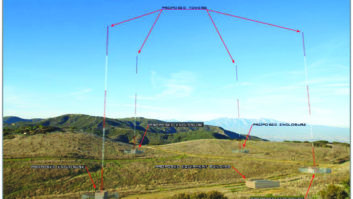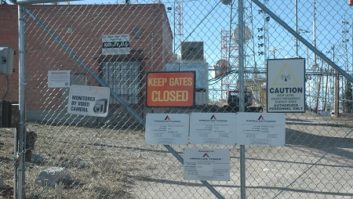Proponents Hope Digital Radios Have Supplemental Channels by Late Fall
Developers of the Tomorrow Radio project – NPR, Kenwood USA and Harris Broadcast – are pleased with test results of the supplemental audio channel concept for HD Radio. If plans go as hoped, the partners expect U.S. stations can begin splitting their digital signals into two distinct channels by late fall.
They’ve concluded, along with Hammett & Edison, which evaluated the results, that the service area of a secondary audio channel for digital stations would fall within the 60 to 70 dBu service area of a typical FM station.
“The coverage area is robust,” said NPR Vice President for Engineering and Operations Mike Starling.
The concept is that instead of a typical station transmitting its digital FM HD Radio signal at 96 kilobits per second, that channel would be split into two digital signals, one at 64 kbps and the other at 32 kbps.
‘Robust’ coverage
The 32 kbps channel could be audio, data or a mixture of both, proponents said.
When asked if the secondary audio channel or SAC sounds as good as a digital channel that hasn’t been divided, Starling said, “It wouldn’t sound as good as if you had not split it up. There’s certainly a tradeoff there.
“I think our experience is that the coding has improved to the point where these are really excellent results, even at the somewhat reduced data rate for the main channel down to 64 kbps and quite good results for the 32-kilobit channel.”
Kenwood USA’s Director of R&D/Digital Broadcast Mike Bergman said, “You will not be unhappy with 32 kbps, depending on its application. If this is someone who has to have the absolute purest classical music reproduction, 32 kpbs is not for that application. But mixtures of speech and music, certain music formats … are going to sound terrific at 32 kbps.”
What the partners wanted to achieve with testing was to determine whether the digital signal, when split, remains robust as far as coverage in a mobile environment.
“We were looking at listenable coverage. With a digital signal, there’s a potential for dropout at the edge of coverage. We consider coverage to be the area where the signal was strong, running for long periods of time,” Bergman said.
An occasional mute of the secondary channel would be tolerable to listeners, but for the most part, the service has to offer relatively seamless coverage, he said.
Unlike the typical FM transmitting an HD Radio signal, there is no fallback blend to analog for the SAC portion of the digital signal; there is an analog fallback for the 64 kpbs channel, but not for the 32 kbps portion. Should the signal fail for the SAC, the receiver mutes that channel only.
Hammett & Edison’s Stan Salek concluded there was 95 percent certainty of coverage within the predicted and measured coverage area for all four stations that were tested: KALW(FM), San Francisco; KKJZ(FM), Long Beach, Calif.; WETA(FM), Washington and WNYC(FM), New York.
New York City had 61dBu contour equivalent coverage and Washington had 64.9 dBu. “New York City is the really impressive one to me because they were only running 56 watts of digital power,” said Starling, explaining that the digital power is 1/100th of the analog power.
He said that showed the SAC could provide reliable coverage to a potential 15.7 million listeners in that area.
Different codecs used
The original tests were performed last summer with Ibiquity’s earlier Perceptual Audio Coder. Regression tests were completed at the end of 2003 with Ibiquity’s new HDC codec in two cities. The additional tests gave the partners a chance to correct deficiencies in the RF distribution network that were identified in the initial data-gathering scheme. A different, simplified configuration was used during regression testing (see diagram.)
The partners said switching codecs by itself did not change the results. Data differences during receiver testing were more likely due to long interruptions in terrain, a strong adjacent carrier or a long distance from the van to a transmitter site. The type of things that cause noise on an analog system also will cause noise on a digital system, they said.
However, “Some significant interference effects were noted from co-channel and adjacent-channel stations,” according to the report.
“An anomalous in-band interfering signal was observed using spectrum analysis techniques on Washington, D.C., Test Route 4 (Highway 4) during original testing, but the signal was no longer present in recent regression testing,” states Hammett & Edison in its report.
“Our data analysis showed that effects from adjacent-channel stations were observed at edge-of-coverage areas on Test Route 2 near Baltimore, Md., and on Test Route 5 near Fredericksburg, Va.
“Testing in other markets did not yield any significant instances of interference. In general, when the station’s 60 dBu service contour was impinged by a strong in-band transmission, there was an observable effect that somewhat reduced the coverage area, which explains the reduced performance in the Washington, D.C., area as compared to the New York City metropolitan area. However, these effects did not dominate the test results.”
To see the report, go to www.npr.org/euonline.
What next?
The partners hope stations can begin partitioning their spectrum for the additional channel by late fall. Additional steps must occur in order to make that proposed timetable.
The four stations used for SAC testing received experimental licenses from the FCC. Starling said proponents hope other stations will seek experimental authority for SAC broadcasts in order to explore what would be required to implement the concept at various kinds of stations.
“It will take some logistic subtleties to work out getting that extra signal from the studio to the transmitter, for example,” Starling said.
Some stations may need an additional STL to do a SAC broadcast, said Harris National Accounts Manager for Radio Lucius Stone. He said implementation costs also include an additional software load for the transmitter, assuming a station already has HD Radio software loaded onto its transmitter exciter.
Bergman likened the costs to do the SAC broadcast to “the cost of two laptops.”
Harris also recommended the Neustar pre-conditioner for stations considering the concept, to pre-process the audio and make the codec’s job of deciding what audio to keep or eliminate easier.
Harris had a SAC broadcast demo set up at the recent CES convention in Las Vegas. Neustar was used in all three implementations, said Harris Applications Engineer Gary Liebisch. The first demo was FM HD Radio at 96 kbps with analog and digital signals at 94.5 MHz. The second demo was FM HD Radio at 102.5 MHz with the digital split into two channels, 64 kbps and 32 kbps. The third demo was AM analog and HD Radio at 36 kbps on 840 kHz.
Interim steps
Michael Riksen, NPR vice president for government relations, said the experimental authority that stations need now to operate HD Radio along with an SAC broadcast is an interim step. He hopes the FCC eventually will not require stations to apply for experimental authority to broadcast the split digital signals.
The partners presented test results to the National Radio Systems Committee at its meeting at CES, soliciting feedback before taking the results to the FCC. They had not yet turned in the final report several weeks later, although proponents have briefed some agency staffers about the concept.
“The FCC will then decide what to do in the context of a Further Notice of Proposed Rule Making,” said Riksen. “The specific action we hope the commission will take is to eliminate the necessity of an experimental license to broadcast a supplemental channel, so that a broadcast of digital radio will, by itself, be sufficient for supplemental audio.”
The agency may bundle Tomorrow Radio with other remaining HD Radio items still to be authorized, such as AM nighttime operation, in the further notice. Or, partners said, they may pursue the supplemental audio channel as a separate item.
The further notice would have to be out this spring in order for the partners to meet their goal of allowing U.S. stations to split their HD Radio signals and offer these new services.
Bergman said receivers would be available when regulators are ready to permit it.
While commercial broadcasters seem to be taking a wait-and-see attitude, some public radio broadcasters are embracing the promise of another digital channel, saying the potential to offer more and different programming along with better audio quality makes a more compelling reason for consumers to buy digital radios.
How to program it?
Scott Hanley, director/general manager of Pittsburgh’s noncom WDUQ(FM), a news and jazz formatted station, said, “Out of an audience of about 160,000 cume (Spring 2003), when I parse out the numbers about 130,000 listen to news, about 100,000 listen to the jazz. There is a lot of crossover, but also a significant number of people who seem to prefer one service or the other.
“By counter-programming a supplementary channel, we hope we can encourage a significant number of people with a strong penchant for one or the other of our major offerings to become early adopters.”
Pubcasters are getting help in the form of matching grants from the Corporation for Public Broadcasting for their digital transition. Close to 50 noncoms are on the air or have received matching grants to move toward implementation of HD Radio.
Last year, CPB doled out about $3 million in digital transition grant funding. Just before the holidays, it invited applications for an additional $6.75 million to assist noncom stations serving rural and minority markets.
Also, contained in an omnibus funding bill passed by Congress in January and signed by the president is an additional $50 million in digital transition funding for radio and TV combined. Riksen said public radio is to get about 15 percent of that, or $7.5 million.
Whether commercial broadcasters would pay a data fee to Ibiquity to broadcast a supplemental channel is undetermined.










